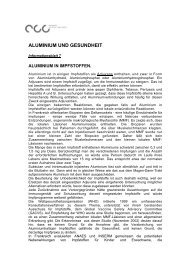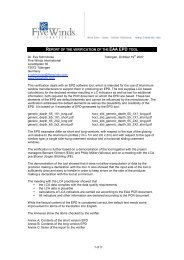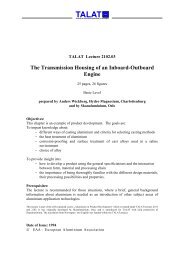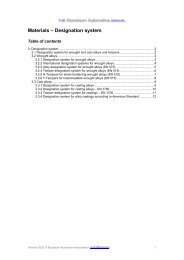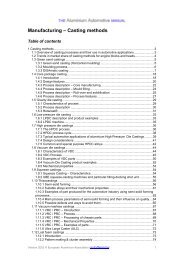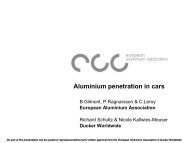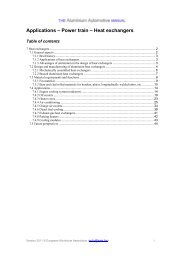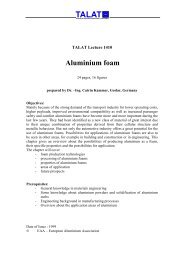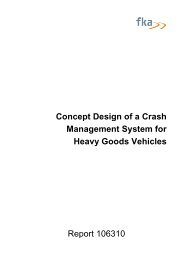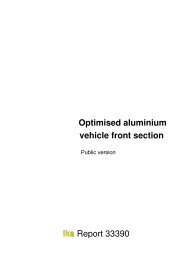aluminium in commercial vehicles - European Aluminium Association
aluminium in commercial vehicles - European Aluminium Association
aluminium in commercial vehicles - European Aluminium Association
Create successful ePaper yourself
Turn your PDF publications into a flip-book with our unique Google optimized e-Paper software.
102 EUROPEAN ALUMINIUM ASSOCIATION ALUMINIUM IN COMMERCIAL VEHICLES CHAPTER VII<br />
4. Drill<strong>in</strong>g<br />
Drill<strong>in</strong>g <strong>alum<strong>in</strong>ium</strong> alloys is a simple<br />
operation but calls for careful<br />
sharpen<strong>in</strong>g and polish<strong>in</strong>g of the<br />
drills given the relative softness<br />
of the <strong>alum<strong>in</strong>ium</strong> alloys used <strong>in</strong><br />
the manufacture of <strong>commercial</strong><br />
<strong>vehicles</strong>. If <strong>in</strong>adequate sharpen<strong>in</strong>g<br />
causes the drill to bend or<br />
buckle, it will tear the metal<br />
around the part of the hole that<br />
is already drilled.<br />
The follow<strong>in</strong>g types of drill can be<br />
used for drill<strong>in</strong>g <strong>alum<strong>in</strong>ium</strong> alloys5 :<br />
• the standard twist drill - the<br />
most common type,<br />
• the straight flute drill,<br />
• the gun drill,<br />
• the half-round or three quarter<br />
round drill.<br />
5. Steel twist drills can be used for small<br />
runs with ma<strong>in</strong>ly manual tools.<br />
4.1. Twist drill<br />
To have a substantial sharpen<strong>in</strong>g<br />
gradient, the helix angle must be<br />
40° while the po<strong>in</strong>t angle varies<br />
from 120° to 140° accord<strong>in</strong>g to<br />
the shape of the neck, with a<br />
clearance angle of 8°. The other<br />
characteristics of the twist drill<br />
are as follows:<br />
• cutt<strong>in</strong>g speed 30 to 80 m/m<strong>in</strong><br />
depend<strong>in</strong>g on rat<strong>in</strong>g and the<br />
desired quality - for very accurate<br />
holes the ideal speed is 30 m/m<strong>in</strong>,<br />
• penetration rate determ<strong>in</strong>ed by<br />
the drill diameter: 0.05 mm/rev<br />
for a 2 mm diameter drill, to 0.3<br />
mm/rev for a 30 mm diameter<br />
drill,<br />
• soluble oil cool<strong>in</strong>g,<br />
• po<strong>in</strong>t height : this must<br />
exceed the thickness of the<br />
drilled material.<br />
4.2. Straight flute drill<br />
This drill facilitates rapid chip<br />
removal and is more efficient for<br />
<strong>alum<strong>in</strong>ium</strong> alloys of medium<br />
hardness than the twist drill. The<br />
four cyl<strong>in</strong>drical witnesses also<br />
prevent "triangulation" of the<br />
hole and provide drill guidance.<br />
4.3. Gun drill<br />
This type of drill is excellent for<br />
large diameter holes of 20 mm<br />
and over, also for drill<strong>in</strong>g stacked<br />
sheets. The drill<strong>in</strong>g conditions are<br />
the same as for the standard<br />
twist drill.<br />
4.4. Half-round or three<br />
quarter round drill<br />
These drills are used ma<strong>in</strong>ly <strong>in</strong><br />
bor<strong>in</strong>g operations. The accuracy<br />
of the bore diameter achieved<br />
with these tools is of the order of<br />
0.02 mm:<br />
• cutt<strong>in</strong>g speeds are between 10<br />
and 15 m/m<strong>in</strong>,<br />
• rate of advance is 0.05 mm/rev,<br />
• cool<strong>in</strong>g is with cutt<strong>in</strong>g oil.



